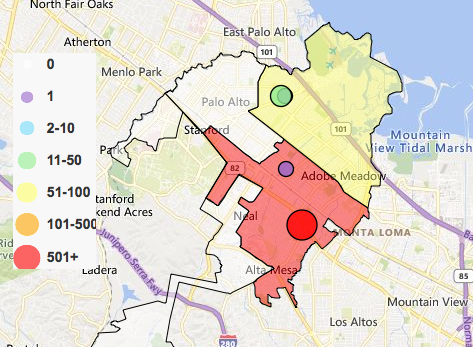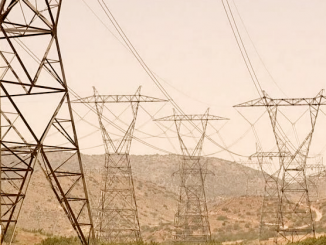
9:19 p.m., Friday, Aug. 14 — Palo Alto Utilities spokeswoman Catherine Elvert said, “Approximately 4,000 City of Palo Alto Utilities customers lost power for about two hours tonight. Due to excessive heat and stress on the electric grid, the state electric grid management agency instructed CPAU to ‘shed electric load.’ We are asking people to please help us reduce demand by unplugging and powering off appliances when not in use, especially during periods of extreme heat. We’re anticipating another hot day tomorrow (Saturday, Aug. 15). We are sharing energy efficiency tips at cityofpaloalto.org/efficiencytips and cityofpaloalto.org/sustainability
8:55 p.m., Friday, Aug. 14 — It appears that power has been restored to all but 140 customers in Palo Alto, according to the Palo Alto Utilities Outage Map. However, north and south of Palo Alto, PG&E is reporting several small outages.
8:06 p.m., Friday, Aug. 14 — The Palo Alto Utilities Outage Map shows that 4,454 customers lost power at 7:37 p.m. today, on one of the hottest days of the year. The outage is concentrated in southwest Palo Alto.
PG&E’s Outage Map shows scattered power interruptions up and down the Peninsula.
It wasn’t immediately known if the outage in Palo Alto was related to the order PG&E received today from the California Independent System Operator (California ISO) to turn off power to about 200,000 to 250,000 customers at a time in rolling blackouts given the strain on the power grid during the heat wave. California hasn’t instituted rolling blackouts in nine years.
However, PG&E’s Outage Map shows 2,532 customers have lost power in a portion of Los Altos bordering on Palo Alto.
Palo Alto operates its own electrical utility, but the power comes to the city through transmission lines operated by PG&E and those lines are part of the California electrical grid.
Californians are being urged to continue to conserve power until 11 p.m. tonight to reduce power usage as supplies run tight during the peak period today.
The Palo Alto Utilities Department has yet to release any information on the cause of the outage.
9:01 p.m., Friday, Aug. 14 — From the Associated Press:
The operator of California’s power grid today ordered rolling power outages for the first time since 2011 as a statewide heat wave strained its electrical system.
The California Independent System Operator (California ISO), which manages the power grid, declared an emergency shortly after 6:30 p.m. and directed utilities around the state to shed their power loads.
PG&E tweeted that it would turn off power to about 200,000 to 250,000 customers in rotating outages for about an hour at a time until around 11 p.m. Other utilities were told to do the same.
“Extreme heat is really the driver behind this,” said Anne Gonzales, spokeswoman for the power grid operator.
The move came as temperatures around the state hit triple digits in many areas, and air conditioning use soared.
Temperatures were 10 to 20 degrees above normal in some areas, Gonzales said.
In addition, cloudy weather from the remnants of a tropical weather system reduced power generation from solar plants, she said.
The state tried to prepare for the expected rise in electricity use by urging conservation and trying to buy more power but a high-pressure system building over Western states meant there was less available.
Temperatures and energy use were expected to drop during the evening, and California ISO expected the outages to end at midnight.
The heat wave is expected to last through next week and the power grid operator will decide whether to continue the rolling outages on a day-to-day basis, Gonzales said.
“We’re dealing with weather, clouds, wildfires … these are quickly evolving situations, quickly changing,” Gonzales said.
The last time the state ordered rolling outages was during an energy crisis in 2011. Blackouts occurred several times from January to May, including one that affected more than 1.5 million customers in March. The cause was a combination of energy shortages and market manipulation by energy wholesalers, infamously including Enron Corp., that drove up prices by withholding supplies.
Counties up and down the state reported scattered outages, although the city of Los Angeles, which has its own power generating system, wasn’t affected.
Police departments warned people to watch out on roads where stoplights were out.
In Sonoma County in the wine country, the Santa Rosa Police Department received a flood of calls and pleaded with residents: “Please do not call 911 unless you have an emergency.”
The heat wave brought dangerously high temperatures, increased wildfire danger and fears of coronavirus spread as people flock to beaches and parks for relief.
Heat records fell in several cities. Downtown San Francisco hit 90 degrees, topping a high for the date of 86 that was set in 1995. Salinas hit 102, 18 degrees above the record set just last year. Palm Springs hit 120, breaking a 2015 record by several degrees.
Sweltering weather was expected to continue into Wednesday across greater Los Angeles, the Central Valley, Sierra Nevada foothills and parts of the San Francisco Bay Area.
Santa Clara, Alameda and Contra Costa counties opened cooling centers that will welcome people this weekend from the afternoon to the early evening. San Francisco officials said the city is recommending people stay home and that if the heat indoors gets intolerable to go outside to a shady place where they can stay cool and distant from other people.
“Congregate indoor sites are not safe necessarily during COVID-19. It is better to follow other instructions during this heat wave,” said Mary Ellen Carroll, executive director of the Department of Emergency Management.
Carroll encouraged residents to check on family, friends and neighbors, especially older adults and those in frail health, and reminded people to always wear a face mask when in the vicinity of people who don’t share their household.
“We know it’s going to be beautiful out this weekend but we just want everyone to remember that we are in a very serious response to this COVID-19 virus,” Carroll said.
Ernesto Guerrero bought a small air conditioner this week for La Tapatia, his restaurant in Martinez, where triple-digit temperatures are predicted. But he said the unit doesn’t do much to cool the cooking areas because the stove runs all day.
“It’s difficult. I tell you, the guys in the kitchen, they should be awarded special hazard pay, because it gets very warm in the kitchen,” Guerrero told KTVU-TV.
Los Angeles opened cooling centers, but with limited capacity because of virus social distancing requirements.
The scorching temperatures are a concern for firefighters battling blazes that have destroyed several homes and erupted near rural and urban foothill neighborhoods, driving through tinder-dry brush.
In addition to the possibility of heat stroke and other hot-weather illnesses, health officers were concerned that people will pack beaches, lakes and other recreation areas without following mask and social distancing orders — a major concern in the state that has seen more than 600,000 coronavirus cases.




Thank God! I was worried I forgot to pay my utilities bill.
Voluntary conservation by turning off air conditioners and other unnecessary appliances sure beats a rolling blackout!
So let me get this straight, if temperature gets too hot PG&E will shut my power off, if it gets too cold PG&E will shut my power off, if it’s windy or raining PG&E will shut my power off. Huh, welcome to the 21st century and PG&E’s ongoing unreliable power infrastructure.
And they keep asking for more money
@Oh Well PG&E will also shut off your power if there is a fire.
California is more third world then a lot of third world countries.
Palo Altans, please stop using electricity after dark. We are mostly solar powered!